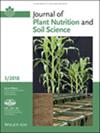Impact of bare fallow management on soil carbon storage and aggregates across a rock fragment gradient
Abstract
Background
Our understanding of C storage in soils lacks insights investigating organic matter (OM) depletion, often studied in bare fallow systems. The content of coarse rock fragments is often excluded, whereas it may affect C storage.
Aims
We aim to contribute to a better understanding of the impact of bare fallow on C storage mechanisms in the soil as influenced by its coarse rock fragment contents. We investigated whether bare fallow induced a depletion of C in OM fractions and analyzed to which extent this affected soil aggregate size distribution and the C loading of the clay-sized fraction.
Methods
A comparison of 14 years bare fallow management with adjacent cropped soils located in Selhausen (Germany) provided a gradient of coarse rock fragments of 34%–71%, from which sites with three different fine earth (FE) contents were compared. Across the FE gradient, we isolated particulate OM and mineral-associated OM fractions, obtained microaggregate and macroaggregate size fractions, and quantified the C loading.
Results
Bare fallow management induced an OM depletion at lower contents of FE. There, the management influence was more concentrated onto less FE volume. The contribution of both particulate and mineral-associated OM fractions to the C in the low-FE soils decreased. The C loading increased under bare fallow, compared to cropped soil. In the low-FE soil, we also found less macroaggregates, whereas the C content decreased in some microaggregate size fractions.
Conclusions
A high content of coarse rock fragments can enhance OM depletion decreasing mineral-associated and particulate C under bare fallow.


 求助内容:
求助内容: 应助结果提醒方式:
应助结果提醒方式:


